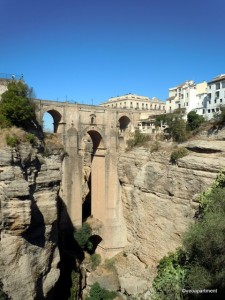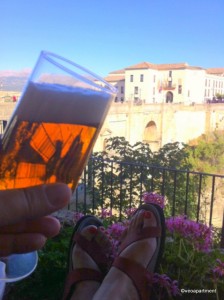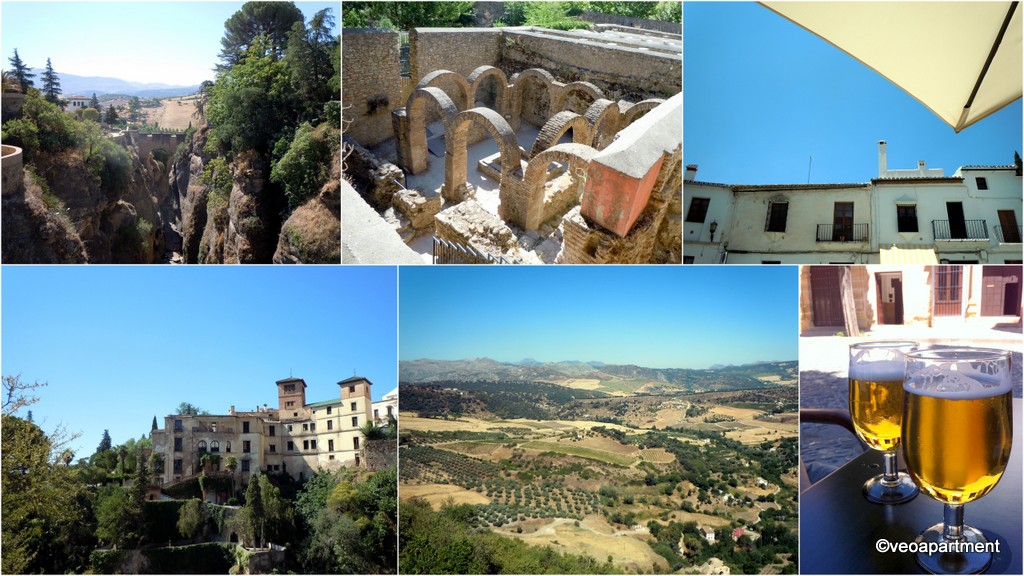 The little city of Ronda is one of Andalucia’s most underrated destinations, and although it’s not quite as easy to get to from Seville as Córdoba and Cádiz, taking about two hours each way on the bus, it’s well worth the extra effort, especially as the road winds through some beautiful mountain scenery.
The little city of Ronda is one of Andalucia’s most underrated destinations, and although it’s not quite as easy to get to from Seville as Córdoba and Cádiz, taking about two hours each way on the bus, it’s well worth the extra effort, especially as the road winds through some beautiful mountain scenery.
For a small town (the population is only about 40,000), Ronda is full of surprises, and when you arrive you should head straight for the first of these – the spectacular Tajo Canyon that cuts the town in half, and the Puente Nuevo or New Bridge (it’s not so new now, as it was built in the second half of the 18th century). From the top of the bridge there is a breathtaking view across the Serranía de Ronda on one side, and an equally breathtaking view of the gorge on the other. The buildings that seem to perch on the very edge of the precipice make it look even deeper. It’s one of Spain’s most impressive and iconic sights, and it’s hard to describe the effect of seeing it for the first time.
Although it’s physically quite hard work, making your way down to the lower bridges, the “Puente Arabé” and the “Roman Bridge“, is an absolute must-do. Go down through the old town past the Casa del Rey Moro (if you’re feeling really strong go to the “water mine”, a tunnel leading down from the gardens to the Rio Guadelevín at the bottom of the gorge), and the Arco de Felipe V, and stopping by the Arab baths at the bottom, and come back up through the Cuenca gardens on the new town side.
Where to eat:
By now you’ll be ready for lunch, and fortunately you’ll be just in the right place. There are several good bars and restaurants in this area. Try Traga Tapas (calle Nueva 4, tel. 952 877 209) for trendy tapas served up in a young hip setting or, at the other end of the spectrum, basic homemade goodness at El Maestro (calle Espinal 7 ) where you’ll find typical Spanish dishes served with a smile. If you’d prefer upscale gourmet then Tragabuches will fit the bill with an excellent tasting menu and equally delicious a la carte selections (calle José Aparicio 1, tel. 952 190 291).
After lunch stroll across the bridge to the old town, take the first turning on your right, and walk around the edge of the city. There are a number of interesting buildings to visit, including the Mondragón Palace, and some stunning views. Top tip – take some time to have a beer or a cold drink in the Plaza de la Duquesa de Parcent, surely one of the most charming and peaceful squares in the whole of Spain. At the far end are the Moorish Puerta (Gate) de Almocábar with a section of the city wall, and the Church of the Holy Spirit, built soon after the city finally fell to the Christians in 1485.
 Ronda is also famous as the place where the modern form of bullfighting (on foot rather than on horseback) developed in the 18th century, so a visit to the bullring, claimed to be the oldest in Spain, and its museum, is another evocative must-see, although actual bullfighting here is now restricted to a single annual event, the Goyesca, in September.
Ronda is also famous as the place where the modern form of bullfighting (on foot rather than on horseback) developed in the 18th century, so a visit to the bullring, claimed to be the oldest in Spain, and its museum, is another evocative must-see, although actual bullfighting here is now restricted to a single annual event, the Goyesca, in September.
In the early evening, a little before dusk and the journey home, stop off at the terrace of the Parador Hotel bar to enjoy the view and watch the swallows and especially the crows, who seem to be just doing it for fun, showing off their aerial virtuosity soaring and diving on the air currents over the gorge.
How To Get There:
- by car – take the A376 to Utrera and then follow the signs to Ronda
- by bus – the shortest run morning bus leaves Sevilla’s Prado de San Sebastian station at 10.15 am arriving in Ronda at 12.15 pm, and the last return bus is at 7.00 pm and takes 2 3/4 hours. Price is 11.57 € one way. For updated schedules check the Los Amarillos Bus Line website.
